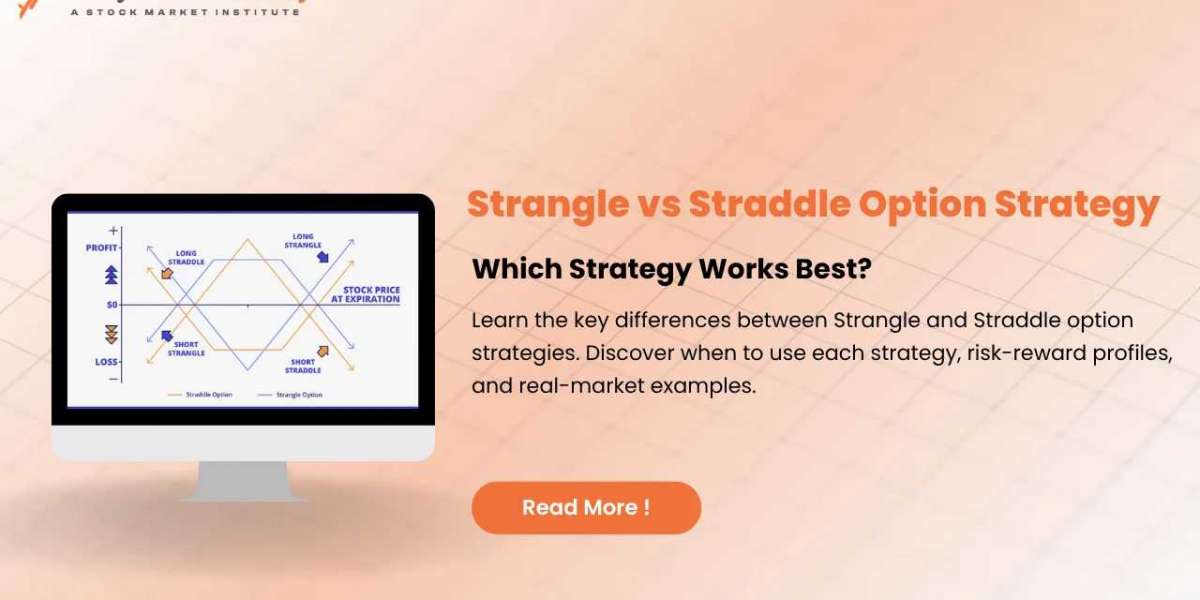Straddle vs Strangle: Choosing the Right Option Strategy for Everyone
Introduction
Have you ever wondered how some investors seem to profit no matter which way the market moves? It’s like having your cake and eating it too! When it comes to options trading, two strategies—straddle vs strangle—can help you do just that. Don’t worry if these terms sound confusing. By the end of this guide, you’ll know exactly what they mean, when to use them, and how to choose the best trading courses to learn more. Let’s dive in and see which strategy could work for you!
Uncover the difference between straddle vs strangle, explore strangle option strategy, and find the best trading courses to boost your trading knowledge.
What is Options Trading?
Options trading might sound intimidating, but think of it as securing the right (but not the obligation) to buy or sell something in the future, at a pre-agreed price.
- Options are contracts that let you bet on a stock’s future price.
- You don’t have to buy the stock itself—just the right to buy or sell it.
- There are two basic types: call options (betting prices will rise) and put options (betting prices will fall).
If you’ve ever reserved a concert ticket but didn’t have to buy it until the day of the event, you’ve already used an “option” in real life!
Introduction to Straddle vs Strangle
Some people think making money in the stock market is just about guessing which way a stock will move. But what if you don’t know? That’s where straddle vs strangle comes in.
- Both strategies let you profit from big moves—up OR down.
- The trick isn’t knowing the direction, but believing the move will be significant.
Understanding the Straddle Option Strategy
What is a Straddle?
Think of a straddle like sitting on a fence, ready to jump off in either direction. With a straddle option strategy, you buy both a call and a put at the same strike price and expiry date for the same stock.
How It Works:
- Buy one call option (betting it’ll go up).
- Buy one put option (betting it’ll go down).
- Both at the same “strike price” (the price you choose ahead of time) and expiration date.
When to Use:
- Before big events, like earnings announcements.
- When you expect a sharp move, but you’re unsure of the direction.
Profit Potential:
- If the stock surges or tumbles beyond a break-even point, you profit.
- If it barely moves, you may lose the premiums (costs) you paid.
Example:
Let’s say Apple is trading at $100. You buy a call and a put, both at $100. If Apple rockets to $120 or crashes to $80, one of your options will likely cover the combined costs and maybe make extra.
Deep Dive: Strangle Option Strategy
What Is a Strangle?
Imagine stretching a rubber band a little wider on both sides. With a strangle option strategy, you buy a call and a put, but at different strike prices.
How It Works:
- Buy a call option ABOVE the current stock price.
- Buy a put option BELOW the current stock price.
- Both share the same expiration date but have different strike prices.
When to Use:
- When you expect a sizeable move, but not as dramatic as a straddle would require to turn a profit.
- When you want to pay less upfront because these options are usually cheaper.
Profit Potential:
- You need a bigger move to reach the break-even point (since the strike prices are further from the current price).
- But if the stock swings enough, you can profit handsomely.
Example:
If Apple trades at $100, you buy a call at $105 and a put at $95. If Apple jumps to $115 or drops to $85, you’ll likely see a gain after covering your initial costs.
Straddle vs Strangle: Key Differences
Straddle | Strangle |
Same strike price | Different strike prices |
Higher upfront cost | Lower upfront cost |
Profit from smaller moves | Needs bigger moves to profit |
More sensitive to movement | Less sensitive |
Pros and Cons of Straddle Strategies
Pros
- Profits from both large upward and downward moves.
- Simple structure—only two trades to manage.
- Great before big news or earnings.
Cons
- Expensive to buy both options at the same price.
- No profit if the stock stays flat.
- Premiums can add up quickly.
Pros and Cons of Strangle Strategies
Pros
- Less expensive—options are cheaper since they’re further from the current price.
- Also profits from big market moves, but with lower risk.
- Flexible—you can choose your strike prices depending on how big you expect the move to be.
Cons
- Stock has to move more for you to make money.
- Might not profit if the move isn’t big enough.
- Complex if you’re not familiar with option pricing.
When Should You Use a Straddle?
- When a major event is coming, and you expect big market swings.
- Earnings reports, product launches, legal decisions, or political outcomes can be triggers.
- If the cost doesn’t scare you, and you want maximum possible movement coverage, a straddle is best.
When Should You Use a Strangle?
- If you think a move is coming but aren’t sure it’ll be massive enough for a straddle to pay off.
- When you have a limited budget to spend on options.
- If you can tolerate a little more risk in exchange for a lower entry cost.
Risk Management for Both Strategies
Let’s be real—not all trades go as planned. That’s why managing risk is essential!
Key Points to Manage Risk:
- Only invest money you can afford to lose.
- Consider setting stop-loss orders to exit losing trades.
- Don’t put all your eggs in one basket—diversify!
- Remember: Both strategies risk losing your entire investment if the stock doesn’t move much.
Real-World Analogies: Straddle Strangle
Straddle Analogy:
- Imagine standing at a crossroads, ready to sprint down whichever road gets busy first. You have tickets for either direction. If traffic roars left or right, you’re ready!
Strangle Analogy:
- It’s like trapping a mouse with two larger, spaced-out cheese traps. The mouse must travel further to be caught, but your cost for bait is lower.
Both approaches are tools to catch action, whether it comes quickly or takes a bigger leap.
Common Mistakes to Avoid
- Overpaying for Premiums: Don’t pick expensive options that make profit unrealistic.
- Ignoring Expiry Dates: Always know when your options expire.
- Not Considering Volatility: These methods only pay when volatility is high.
- Forgetting Commissions: Trading fees add up.
Tips for Beginners
- Start small—trade with amounts you’re comfortable losing.
- Use virtual trading platforms to practice before risking real money.
- Learn from the best: The best trading courses offer valuable, practical insights.
- Always keep learning—markets evolve, and so should you!
- Review your trades, even the losing ones—there’s a lesson in every trade.
Best Trading Courses to Master These Strategies
Want to get hands-on and truly understand straddle vs strangle and the ins and outs of the strangle option strategy? Here are some avenues to explore:
- Look for courses that teach options basics and strategy application.
- Consider platforms like Coursera, Udemy, and Investopedia Academy.
- Seek courses that offer real-life examples, not just theory.
- The best trading courses will teach you risk management, psychology, and practical tips for live markets.
- Don’t forget: Free resources (YouTube, financial websites) can also provide excellent introductions before buying a paid course.
Conclusion and Key Takeaways
So, what’s the verdict in the straddle vs strangle debate? There’s no one-size-fits-all answer. If you want to capture big moves regardless of direction and don’t mind paying a bigger upfront cost, a straddle might suit you. If you’re looking to profit from significant events with less risk and a smaller budget, a strangle could be your go-to. Study these strategies, understand your own risk tolerance, and keep learning—especially through the best trading courses you can find. The sky’s the limit when you’re equipped with knowledge!
Frequently Asked Questions (FAQs)
- What is the primary difference between a straddle and a strangle option strategy?
A straddle uses options at the same strike price, while a strangle uses different strike prices, making the straddle more sensitive to movement but usually more expensive. - Can beginners use straddle and strangle strategies?
Yes, but it’s wise for beginners to start with small amounts and practice using virtual accounts before investing real money. - Are there risks involved with these strategies?
Absolutely. You risk losing your entire investment if the stock doesn’t move enough to cover the cost of the options. - How do I find the best trading courses to learn these strategies?
Look for courses from reputable providers that offer practical examples, risk management, and hands-on trading practice. - Which strategy is better for unpredictable markets?
Both can work, but straddles may be preferred when you expect bigger moves, while strangles can be better if you’re seeking lower cost with still substantial movement.








